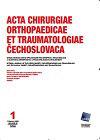胫骨板水平方位角用于下肢远端正面对齐评估。
IF 0.4
4区 医学
Q4 ORTHOPEDICS
Acta chirurgiae orthopaedicae et traumatologiae Cechoslovaca
Pub Date : 2023-04-01
DOI:10.55095/achot2023/018
引用次数: 0
摘要
膝关节周围截骨术是一种通过在膝关节内和周围重新分配身体重量和力量来治疗膝骨关节炎和其他膝关节疾病的既定技术。本研究的目的是确定胫骨平台水平方位角(TPHA)是否是描述胫骨远端在冠状面上脚踝对齐的可靠指标。材料和方法这项回顾性研究包括接受髁上旋转截骨术矫正股骨扭转的患者。所有患者在术前和术后均进行了站立放射线照相,双膝向前。收集了5个变量,包括机械性胫骨远端外侧角(mLDTA)、机械性踝关节角(mMA)、踝关节水平定向角(MHA)、胫骨平台水平方位角(TPHA)和胫骨-距骨倾斜角(TTTA)。使用Wilcoxon符号秩检验对术前和术后测量值进行比较。结果本研究共纳入146例患者,平均年龄为51.47±11.87岁。其中男性92例(63.0%),女性54例(37.0%)。MHA从术前14.0°±5.32°降至术后10.59°±3.93°(p<0.001),TPHA从术前4.88°±4.07°降至术前3.82±3.10°(p=0.013)。TPHA的变化与MHA的变化显著相关(r=0.185,CI 0.023-0.337;p=0.025)。术前和术后的mLDTA、mMA和mMA测量值之间没有差异。讨论在截骨术前计划时应考虑踝关节的方向,并在术后踝关节疼痛的情况下进行测量。结论TPHA是一种可靠的测量方法,可用于描述胫骨远端踝关节在额平面上的对齐情况。关键词:截骨,踝关节,复位,冠状位对齐,术前计划。本文章由计算机程序翻译,如有差异,请以英文原文为准。
The Tibia Plafond Horizontal Orientation Angle for Frontal Alignment Evaluation of the Distal Lower Extremity.
PURPOSE OF THE STUDY Osteotomies around the knee are an established technique for treating knee osteoarthritis and other knee conditions by redistributing the body's weight and force within and around the knee joint. The aim of this study was to determine if the Tibia Plafond Horizontal Orientation Angle (TPHA) is a reliable measure for describing ankle alignment of the distal tibia in the coronal plane. MATERIALS AND METHODS This retrospective study included patients who underwent supracondylar rotational osteotomies for correction of femoral torsion. All patients had standing radiographs taken preoperatively and postoperatively with both knees pointed forward. Five variables, including Mechanical Lateral Distal Tibia Angle (mLDTA), Mechanical Malleolar Angle (mMA), Malleolar Horizontal Orientation Angle (MHA), Tibia Plafond Horizontal Orientation Angle (TPHA), and Tibio Talar Tilt Angle (TTTA), were collected. The preoperative and postoperative measurements were compared to each other using the Wilcoxon signed rank test. RESULTS A total of 146 patients were included in the study, with a mean age of 51.47 ± 11.87 years. There were 92 (63.0%) males and 54 (37.0%) females. MHA decreased from 14.0° ± 5.32° preoperatively to 10.59° ± 3.93° (p < 0.001) postoperatively, and TPHA decreased from 4.88° ± 4.07° preoperatively to 3.82 ± 3.10° (p = 0.013) postoperatively. The change in TPHA was significantly correlated with the change in MHA (r = 0.185, CI 0.023 - 0.337; p = 0.025). No differences were found between the measurements of mLDTA, mMA, and mMA pre- and postoperatively. DISCUSSION The orientation of the ankle should be taken into consideration during preoperative planning of osteotomies and should be measured in cases of postoperative ankle pain. CONCLUSIONS The TPHA is a reliable measure for describing ankle alignment of the distal tibia in the frontal plane. Key words: osteotomy, ankle, realignment, coronal alignment, preoperative planning.
求助全文
通过发布文献求助,成功后即可免费获取论文全文。
去求助
来源期刊
CiteScore
0.70
自引率
25.00%
发文量
53
期刊介绍:
Editorial Board accepts for publication articles, reports from congresses, fellowships, book reviews, reports concerning activities of orthopaedic and other relating specialised societies, reports on anniversaries of outstanding personalities in orthopaedics and announcements of congresses and symposia being prepared. Articles include original papers, case reports and current concepts reviews and recently also instructional lectures.

 求助内容:
求助内容: 应助结果提醒方式:
应助结果提醒方式:


